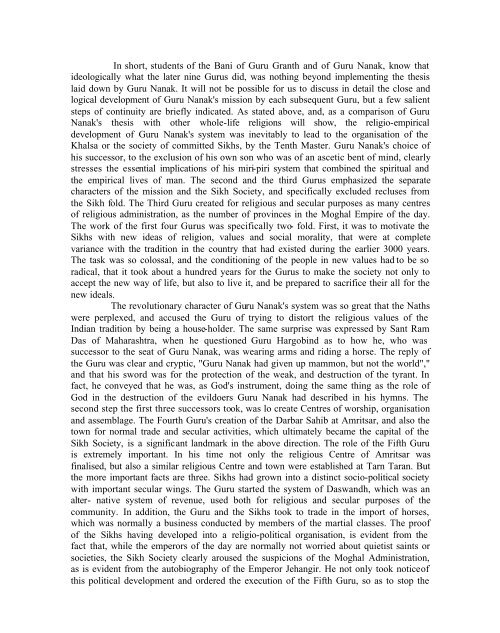Fundamentalism and the Sikh Religious Tradition by T.N. Madan
Fundamentalism and the Sikh Religious Tradition by T.N. Madan
Fundamentalism and the Sikh Religious Tradition by T.N. Madan
Create successful ePaper yourself
Turn your PDF publications into a flip-book with our unique Google optimized e-Paper software.
In short, students of <strong>the</strong> Bani of Guru Granth <strong>and</strong> of Guru Nanak, know that<br />
ideologically what <strong>the</strong> later nine Gurus did, was nothing beyond implementing <strong>the</strong> <strong>the</strong>sis<br />
laid down <strong>by</strong> Guru Nanak. It will not be possible for us to discuss in detail <strong>the</strong> close <strong>and</strong><br />
logical development of Guru Nanak's mission <strong>by</strong> each subsequent Guru, but a few salient<br />
steps of continuity are briefly indicated. As stated above, <strong>and</strong>, as a comparison of Guru<br />
Nanak's <strong>the</strong>sis with o<strong>the</strong>r whole-life religions will show, <strong>the</strong> religio-empirical<br />
development of Guru Nanak's system was inevitably to lead to <strong>the</strong> organisation of <strong>the</strong><br />
Khalsa or <strong>the</strong> society of committed <strong>Sikh</strong>s, <strong>by</strong> <strong>the</strong> Tenth Master. Guru Nanak's choice of<br />
his successor, to <strong>the</strong> exclusion of his own son who was of an ascetic bent of mind, clearly<br />
stresses <strong>the</strong> essential implications of his miri-piri system that combined <strong>the</strong> spiritual <strong>and</strong><br />
<strong>the</strong> empirical lives of man. The second <strong>and</strong> <strong>the</strong> third Gurus emphasized <strong>the</strong> separate<br />
characters of <strong>the</strong> mission <strong>and</strong> <strong>the</strong> <strong>Sikh</strong> Society, <strong>and</strong> specifically excluded recluses from<br />
<strong>the</strong> <strong>Sikh</strong> fold. The Third Guru created for religious <strong>and</strong> secular purposes as many centres<br />
of religious administration, as <strong>the</strong> number of provinces in <strong>the</strong> Moghal Empire of <strong>the</strong> day.<br />
The work of <strong>the</strong> first four Gurus was specifically two- fold. First, it was to motivate <strong>the</strong><br />
<strong>Sikh</strong>s with new ideas of religion, values <strong>and</strong> social morality, that were at complete<br />
variance with <strong>the</strong> tradition in <strong>the</strong> country that had existed during <strong>the</strong> earlier 3000 years.<br />
The task was so colossal, <strong>and</strong> <strong>the</strong> conditioning of <strong>the</strong> people in new values had to be so<br />
radical, that it took about a hundred years for <strong>the</strong> Gurus to make <strong>the</strong> society not only to<br />
accept <strong>the</strong> new way of life, but also to live it, <strong>and</strong> be prepared to sacrifice <strong>the</strong>ir all for <strong>the</strong><br />
new ideals.<br />
The revolutionary character of Guru Nanak's system was so great that <strong>the</strong> Naths<br />
were perplexed, <strong>and</strong> accused <strong>the</strong> Guru of trying to distort <strong>the</strong> religious values of <strong>the</strong><br />
Indian tradition <strong>by</strong> being a house-holder. The same surprise was expressed <strong>by</strong> Sant Ram<br />
Das of Maharashtra, when he questioned Guru Hargobind as to how he, who was<br />
successor to <strong>the</strong> seat of Guru Nanak, was wearing arms <strong>and</strong> riding a horse. The reply of<br />
<strong>the</strong> Guru was clear <strong>and</strong> cryptic, "Guru Nanak had given up mammon, but not <strong>the</strong> world","<br />
<strong>and</strong> that his sword was for <strong>the</strong> protection of <strong>the</strong> weak, <strong>and</strong> destruction of <strong>the</strong> tyrant. In<br />
fact, he conveyed that he was, as God's instrument, doing <strong>the</strong> same thing as <strong>the</strong> role of<br />
God in <strong>the</strong> destruction of <strong>the</strong> evildoers Guru Nanak had described in his hymns. The<br />
second step <strong>the</strong> first three successors took, was lo create Centres of worship, organisation<br />
<strong>and</strong> assemblage. The Fourth Guru's creation of <strong>the</strong> Darbar Sahib at Amritsar, <strong>and</strong> also <strong>the</strong><br />
town for normal trade <strong>and</strong> secular activities, which ultimately became <strong>the</strong> capital of <strong>the</strong><br />
<strong>Sikh</strong> Society, is a significant l<strong>and</strong>mark in <strong>the</strong> above direction. The role of <strong>the</strong> Fifth Guru<br />
is extremely important. In his time not only <strong>the</strong> religious Centre of Amritsar was<br />
finalised, but also a similar religious Centre <strong>and</strong> town were established at Tarn Taran. But<br />
<strong>the</strong> more important facts are three. <strong>Sikh</strong>s had grown into a distinct socio-political society<br />
with important secular wings. The Guru started <strong>the</strong> system of Dasw<strong>and</strong>h, which was an<br />
alter- native system of revenue, used both for religious <strong>and</strong> secular purposes of <strong>the</strong><br />
community. In addition, <strong>the</strong> Guru <strong>and</strong> <strong>the</strong> <strong>Sikh</strong>s took to trade in <strong>the</strong> import of horses,<br />
which was normally a business conducted <strong>by</strong> members of <strong>the</strong> martial classes. The proof<br />
of <strong>the</strong> <strong>Sikh</strong>s having developed into a religio-political organisation, is evident from <strong>the</strong><br />
fact that, while <strong>the</strong> emperors of <strong>the</strong> day are normally not worried about quietist saints or<br />
societies, <strong>the</strong> <strong>Sikh</strong> Society clearly aroused <strong>the</strong> suspicions of <strong>the</strong> Moghal Administration,<br />
as is evident from <strong>the</strong> autobiography of <strong>the</strong> Emperor Jehangir. He not only took notice of<br />
this political development <strong>and</strong> ordered <strong>the</strong> execution of <strong>the</strong> Fifth Guru, so as to stop <strong>the</strong>
















